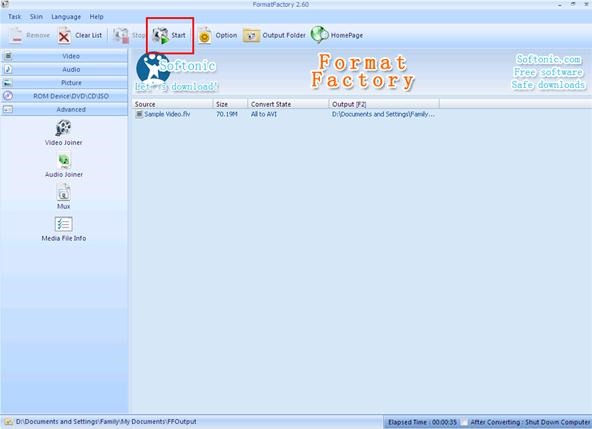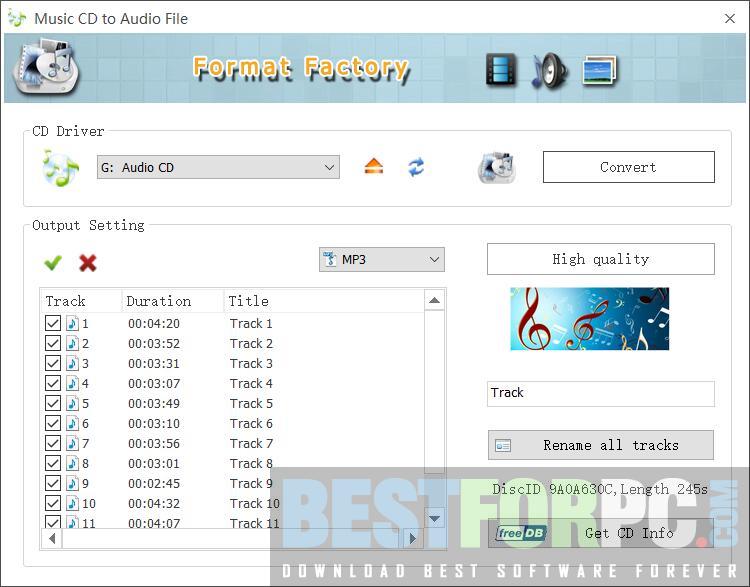- Free Download Format Factory Converter
- Format Factory Mac Download
- Imac Factory Reset
- How To Reset A Macbook
Have you ever been faced with the need to install a new operating system on a crashed PC but realize that you don't have the installation disc? For most people, such a case is always discouraging and disheartening because they know that the only way to install a new OS is to use an installation disc. Actually, all you need is a USB with a good capacity and a utility like Rufus. Rufus is a free, portable open-source utility that you can use to create bootable USB flash drives. Rufus is small in size, but it surprisingly has everything you need as far as the above are concerned.
How to install Format Factory for Mac using WineskinSong Used: 2nd Flight by Approaching NirvanaHere is their channel: http://www.youtube.com/user/Approachin.
Does Rufus Have a Mac Version?
Rufus is primarily a Windows application and currently, it supports 64 or 32 bit Windows XP/7/8/10 only. This means that you can not use Rufus on the normal Mac computers. If you need to run Rufus on a Mac, then it will be imperative for the computer to have a dual boot Windows installed on Mac. However, this is not an easy task at all.
To those in the dark, this simply means that you will need to have a Windows Operating system installed in your Mac computer. However, if you didn't want to have two operating systems running on the same machine so that you can access Rufus, there are quite a number of alternatives you can use to achieve the same functionalities of Rufus on Mac.
Rufus for Mac Alternative 1: UUByte ISO Editor
- Downloading Disk Drill for macOS. Thank you for choosing Disk Drill. Download the disk image, double-click it, drag the Disk Drill app to Applications folder and launch it from there. If your download didn't start, please click here. Need Disk Drill for an older Mac? Disk Drill 3.8. Mac OS X 10.9.5–10.15. Disk Drill 3.7. Mac OS X 10.
- Instructions below are for 10.13.x (High Sierra) 1. Open Disk Utility. Please See Answer 20985: How to access Disk Utility macOS 2. In the top menu bar, go to View, and choose Show All Devices. Select the upper level of the drive you would like to format and click the Erase button. Choose how you would like to format the drive.
- Reinstall macOS. Select Reinstall macOS from the utilities window in macOS Recovery, then click Continue and follow the onscreen instructions. Follow these guidelines during installation: If the installer asks to unlock your disk, enter the password you use to log in to your Mac. If the installer doesn't see your disk, or it says that it can't.
UUByte ISO Editor is by far one of the best ISO toolkits for those who want a seamless process in creating, burning, extracting and editing ISO images. Unlike Rufus, it has both Windows and Mac versions so you don't have to worry about not having Rufus for Mac or the need to install two operating systems in your Mac.
This ISO editor can effortlessly burn ISO image to DVD, CD or USB which you can then go ahead and use as a bootable disc for new installation. The tool is also versatile enough to create an ISO archive from folders or external sources, in addition to extracting or mounting ISO files to Mac or Windows computers. With over 220,000 users worldwide, it is a clear winner among the ISO toolkits available in the market today.

Why Choose UUByte ISO Editor
- Full ISO toolkit for Windows and Mac.
- Easily create bootable USB or DVD from Windows ISO.
- 5X faster burning speed.
- Excellent customer support.
How to burn ISO to USB on Mac using UUByte ISO Editor: Please download UUByte ISO Editor for Mac and install the app. Then drag and drop the app icon to Application folder so you can open the app from Launchpad. After that, insert a USB stick and click 'Burn' button at the first screen. Now import Windows ISO to the program and start burning ISO to USB by clicking 'Burn' button at the bottom of the Window. Finally, wait for 10 minutes to get the job done.
Rufus for Mac Alternative 2: UNetbootin
Unetbootin (Universal Netboot Installer) , is another cross-platform utility toolkit that makes a great alternative to Rufus on Mac. It has the ability to load and install various Linux distros on Mac. It is easy to use and supports a myriad of platforms. All you have to do is select an ISO file or the specific distribution you want to download and then simply choose the target drive. It also comes with a nice GUI, which further adds to the user experience during use.
Pros:
- Support Windows, Mac and Linux.
- Able to download Linux ISO within the program.
- Easily create ISO image from files or folders.
Cons:
- Non-native user interface.
- Lower success rate on new USB drives.
- Lack support for CD or DVD.
Rufus for Mac Alternative 3: Etcher
Etcher is another great Rufus alternative for Mac. It has been designed to allow you to easily and comfortably burn ISO images to USB drives and SD cards. The utility comes with an advanced interface which may be intimidating on first glance, but after going through the simple user guide, getting around to use the utility becomes a breeze.
Simply download this tool, launch it, and then choose the IMG file you are interested in burning. You will then select the location of the target USB drive or SD card and then wait for it to do its magic. It is lightweight and relatively fast, so you won't have to wait for a whole day for the burning process to end.
Pros:
- Polish user interface.
- Support USB drives as well as SD cards.
- Easy to use.
Cons:
- Being loaded slowly on startup.
- Get stuck at burning process easily.
- Poor support for Windows 10 ISO.
Verdict:

Rufus is a great application for burning ISO to USB. Unfortunately, there is no Mac version yet. So for burning ISO to USB on Mac, you have to use third-party alternatives like UUByte ISO Editor to get it done. The suggestions in this post almost do the same thing as Rufus on Windows so don't worry about the functionality. Go ahead and pick up the best rufus alternative according to your experience.
Start up from macOS Recovery
Determine whether you're using a Mac with Apple silicon, then follow the appropriate steps:
Apple silicon
Turn on your Mac and continue to press and hold the power button until you see the startup options window. Click the gear icon labeled Options, then click Continue.

Intel processor
Make sure that your Mac has a connection to the internet. Then turn on your Mac and immediately press and hold Command (⌘)-R until you see an Apple logo or other image.
If you're asked to select a user you know the password for, select the user, click Next, then enter their administrator password.
Reinstall macOS
Free Download Format Factory Converter
Select Reinstall macOS from the utilities window in macOS Recovery, then click Continue and follow the onscreen instructions.
Format Factory Mac Download
Follow these guidelines during installation:
Imac Factory Reset
- If the installer asks to unlock your disk, enter the password you use to log in to your Mac.
- If the installer doesn't see your disk, or it says that it can't install on your computer or volume, you might need to erase your disk first.
- If the installer offers you the choice between installing on Macintosh HD or Macintosh HD - Data, choose Macintosh HD.
- Allow installation to complete without putting your Mac to sleep or closing its lid. Your Mac might restart and show a progress bar several times, and the screen might be empty for minutes at a time.

After installation is complete, your Mac might restart to a setup assistant. If you're selling, trading in, or giving away your Mac, press Command-Q to quit the assistant without completing setup. Then click Shut Down. When the new owner starts up the Mac, they can use their own information to complete setup.
Other macOS installation options
When you install macOS from Recovery, you get the current version of the most recently installed macOS, with some exceptions:
- On an Intel-based Mac: If you use Shift-Option-Command-R during startup, you're offered the macOS that came with your Mac, or the closest version still available. If you use Option-Command-R during startup, in most cases you're offered the latest macOS that is compatible with your Mac. Otherwise you're offered the macOS that came with your Mac, or the closest version still available.
- If the Mac logic board was just replaced, you may be offered only the latest macOS that is compatible with your Mac. If you just erased your entire startup disk, you may be offered only the macOS that came with your Mac, or the closest version still available.
You can also use these methods to install macOS, if the macOS is compatible with your Mac:
How To Reset A Macbook
- Use the App Store to download and install the latest macOS.
- Use the App Store or a web browser to download and install an earlier macOS.
- Use a USB flash drive or other secondary volume to create a bootable installer.